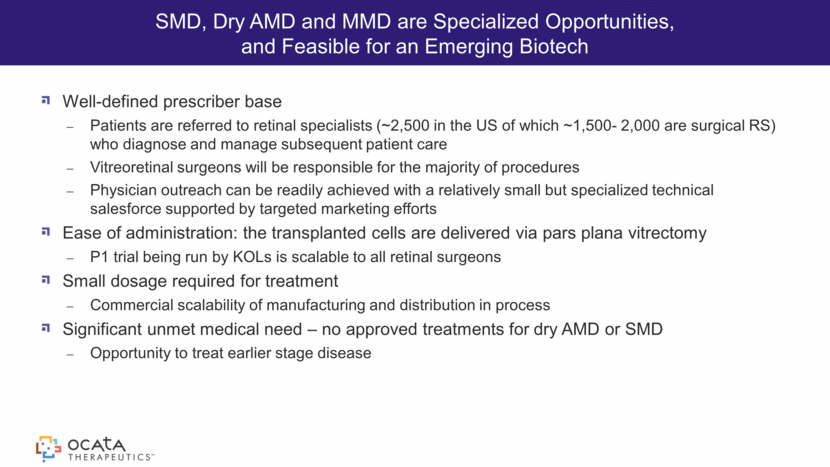Ocata's hESC RPE Cell Therapeutic Candidate Review for Alexey Bersenev @ Stem Cell Assays
Product candidate name: hESC-MA09 RPE (no trade name yet)
Developer: Ocata Therapeutics Inc. (formerly Advanced Cell Technology Inc.)
History
of development: Since 2003
Type of cells: Human allogeneic embryonic stem cell-derived retinal pigment epithelium (RPE), expanded ex vivo.
Tissue source: Blastomere cell derived from fertilized oocytes. Pre-embryo consent use provided as supernumerary tissue for cell extraction for science rather than discarding during standard IVF treatment. Patented non-embryo destructive technology (NED) used to establish hESC cell line – MA09.
Processing steps: Chemical ZP breaching, single blastomere cell extraction, isolated cell co-culture with pluripotent/hES cells in a Quinn’s Cleavage Medium, further culture steps using Quinn Blastocyst Medium on mitomycin C-treated MEF feeder layer with DMEM & bFGF. hESC master cell line established & banked. RPE spontaneous derivation following continued hES cell culturing methods, on MEF in medium without LIF, FGF and Plasmanate or from suspended embryoid body overgrowths in long term culture. The resulting pigmented islands of cells are enzymatically digested and RPE cells isolated and plated for differentiated primary cell cultures for passaging, expansion, working cell bank, harvest & cryopreservation.
Expansion: RPE population doublings ∼20
Phenotypic composition: Pax6-, bestrophin+, CRALBP+, PEDF+, RPE65+.
Exhibit a characteristic cobblestone, polygonal, epithelial-like appearance and comprise brown pigment dispersed within their cytoplasm.
Exhibit a characteristic cobblestone, polygonal, epithelial-like appearance and comprise brown pigment dispersed within their cytoplasm.
Stability/Safety: Genetically stable, normal karyotype, normal senescence & terminally differentiated to its RPE fate
Proposed mechanisms of action and potency: RPE cell replacement therapy aimed to restore lost retina cells at the base of the macula to establish a new and healthy support layer to the photoreceptors (Vitamin A, phagocytosis & waste processes, nutrients & factors). It is envisioned that by replacing the lost RPE layer the remaining photoreceptors will once again function properly thereby either arresting the decline of the age related condition or actually improve lost visual acuity.
Key publications:
- Human embryonic stem cell-derived retinal pigment epithelium in patients with age-related macular degeneration and Stargardt’s macular dystrophy: follow-up of two open-label phase 1/2 studies (Lancet, 2014)
- Embryonic stem cell trials for macular degeneration: a preliminary report (Lancet, 2012)
- Long-term Safety and Function of RPE from Human Embryonic Stem Cells in Preclinical Models of Macular Degeneration (Stem Cells, 2009)
- Human Embryonic Stem Cell Lines Generated without Embryo Destruction – (Cell Stem Cell, 2007)
- Derivation of human embryonic stem cells from single blastomeres – (Nature Protocols, 2007)
(all publications are available for download on Ocata Therapeutics website)
Ongoing trials:
- Phase 1/2a USA – Age Related Macular Degeneration – Geographic Atrophy –NCT01344993
- Phase 1/2a USA – Stargardt’s Macular Dystrophy – NCT01345006
- Phase 1/2a UK – Stargardt’s Macular Dystrophy – NCT01469832
- Phase 1/2 Korea – Age Related Macular Degeneration – Geographic Atrophy –NCT01674829
- Phase 1/2 Korea – Stargardt’s Macular Dystrophy – NCT01625559
Administration: Vitrectomy with sub-retinal injection of cell suspension with dosing from 50,000 to 200,000 cells (Phase 1/2 design). Expected increase in ceiling for cell dose beyond 200,000 in Phase 2.
Key patents:
Blastomere hESC Culture System: – WO2006052646 & WO2007130664, US7838727 &US7893315 & US8642328 & US8742200 & US8796021, Espacenet Family
Stem Cell Derived RPE Cells: – WO2005070011 & WO2006080952 & WO2009051671 & WO2011063005 & WO2013074681, US7736896 & US7794704 & US7795025 &US8268303, Espacenet Family & Espacenet Family & Espacenet Family & Espacenet Family.
IP Positioning summary:
Ocata has arguably the leading clinical program for potentially curative cell therapeutics targeting AMD, SMD & MMD and other unmet medical conditions of the Eye. It’s IP in the area is considered robust and a growing “patent thicket” inhibitor to competitive segment entry using pluripotent cells. Dr. Paul Wotton, CEO of Ocata states that the company has an “Established IP position in major markets protecting the life span of the cell therapy – from the origin of the cell to the delivery into the patients’ eyes – hESC Blastomere, RPE Methods, Assays, Pharma Prep & Treatment Methods” Dr. Paul Wotton, CEO, Ocata Therapeutics, BioCEO N.Y. Feb. 2015.
There are two companies currently pursuing hESC RPE Dry AMD suspension products in the clinic – Cell Cure (a subsidiary of BioTime) and Ocata Therapeutics (previously Advanced Cell Technology). These two programs use different hESC source processes & RPE derivation methods to produce their RPE cell therapeutic product. Cell Cure’s product is from an hESC sourced from a blastocyst while Ocata’s product is sourced from an earlier pre-embryo state at the blastomere stage. Both groups differentiate their hESCs to a pure terminal RPE population. Cell Cure’s product uses a more chemically directed culture method which results in a stable RPE cell. Cell Cure’s program is almost 4 years behind Ocata’s lead.
In relation to Ocata’s hESC RPE suspension product therapy competition please see the following link: BTX Hadasit
Web Links, Related Posts & Misc. Media
Articles:
________________________________________________________________
In order to provide further details of Ocata's lead program area focus, the Eye, I've provided the company's slides from a recent presentation, in which "Regenerative Ophthalmology" was highlighted.
Cheers


.jpg)

.gif)

























